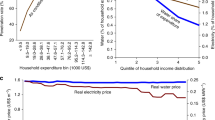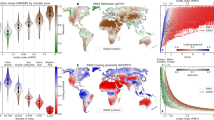Abstract
Water scarcity, energy consumption, and air temperature regulation are three critical resource and environmental challenges linked to urban population growth. While appliance efficiency continues to increase, today’s homes are larger and residents are using more energy-consuming devices. Recent research has often described the energy–water nexus as a “tradeoff” between energy and water due to reduced temperatures resulting from irrigated vegetation. Accordingly, some arid cities have implemented landscape-conversion programs that encourage homeowners to convert their yards from grass (mesic) to drought-tolerant (xeric) landscapes to help conserve water resources. We investigated these relationships in Phoenix, Arizona by examining energy and water data for the summer months of June–September 2005 while temperature variability was analyzed from a local heat wave. Results show parallel consumption patterns with energy and water use strongly correlated and newer homes using more of both. The counterintuitive findings show that “drought-resistant” models may not be beneficial for community health, environment, or economics and that this issue is further complicated by socio-economic variables.




Similar content being viewed by others
References
Addink S (2005) “Cash for grass” a cost effective method to conserve landscape water? Turfgrass Research Facility, University of California, Riverside. Online. Available at: http://agops.ucr.edu/turf/topics/Cash-for-Grass.pdf
Aitken CK, McMahon TA, Wearing AJ, Finlayson BL (1994) Residential water use: predicting and reducing consumption1. J Appl Soc Psychol 24:136–158
Al-Ghandoor A, Jaber JO, Al-Hinti I, Mansour IM (2009) Residential past and future energy consumption: potential savings and environmental impact. Renew Sust Energ Rev 13:1262–1274
Baker LA, Brazel AJ, Selover N, Martin C, McIntyre N, Steiner FR, Nelson A, Musacchio L (2002) Urbanization and warming of Phoenix (Arizona, USA): impacts, feedbacks and mitigation. Urban Ecosyst 6:183–203
Balling R, Cubaque H (2009) Estimating future residential water consumption in Phoenix, Arizona based on simulated changes in climate. Phys Geogr 30:308–323
Balling RC Jr, Gober P, Jones N (2008) Sensitivity of residential water consumption to variations in climate: an intraurban analysis of Phoenix, Arizona. Water Resour Res 44, W10401
Brazel A, Selover N, Vose R, Heisler G (2000) The tale of two climates—Baltimore and Phoenix urban LTER sites. Clim Res 15:123–135
Brazel A, Gober P, Lee S, Grossman-Clarke S, Zehnder J, Hedquist B, Comparri E (2007) Determinants of changes in the regional urban heat island in metropolitan Phoenix (Arizona, USA) between 1990 and 2004. Clim Res 33:171–182
Census Bureau (2000) American fact finder. Available at: http://www.census.gov
Census Bureau (2010) American fact finder. Available at: http://www.census.gov
Chow W, Brazel A (2011) Assessing xeriscaping as a sustainable heat island mitigation approach for a desert city. Build Environ 47:170–181
Chow W, Brennan D, Brazel A (2012) Urban heat island research in Phoenix, AZ: theoretical contributions and policy applications. Bull Am Meteorol Soc 93:517–530
City of Mesa (2007) http://www.cityofmesa.org/utilities/conservation
Cooley H, Fulton J, Gleick PH (2011) Water for energy: future water needs for electricity in the intermountain west. Pacific Institute, Oakland, CA
Easterling DR, Meehl GA, Parmesan C, Changnon SA, Karl TR, Mearns LO (2000) Climate extremes: observations, modeling, and impacts. Science 289:2068–2074
Endter-Wada J, Kurtzman J, Keenan SP, Kjelgren RK, Neale CMU (2008) Situational waste in landscape watering: residential and business water use in an urban Utah community1. JAWRA J Am Water Resour Assoc 44:902–920
Gober P (2006) Metropolitan Phoenix place making and community building in the desert. University of Pennsylvania Press, Philadelphia
Gober P (2010) Desert urbanization and the challenges of water sustainability. Curr Opin Environ Sustain 2:144–150
Gober P, Brazel A, Quay R, Myint S, Grossman-Clarke S, Miller A, Rossi S (2010) Using watered landscapes to manipulate urban heat island effects: how much water will it take to cool Phoenix? J Am Plan Assoc 76:109–121
Greene S, Kalkstein LS, Mills DM, Samenow J (2011) An examination of climate change on extreme heat events and climate†mortality relationships in large US cities. Weather Clim Soc 3:281–292
Gregory GD, Leo MD (2003) Repeated behavior and environmental psychology: the role of personal involvement and habit formation in explaining water consumption1. J Appl Soc Psychol 33:1261–1296
Grimm NB, Redman CL (2004) Approaches to the study of urban ecosystems: the case of Central Arizona—Phoenix. Urban Ecosyst 7:199–213
Grossman-Clarke S, Zehnder J, Stefanov W, Liu Y, Zoldak M (2005) Urban modifications in a mesoscale meteorological model and the effects on near-surface variables in an arid metropolitan region. J Appl Meteorol 44:1281–1297
Grossman-Clarke S, Zehnder J, Loridan T, Grimmond S (2010) Contribution of land use changes to near surface air temperatures during recent summer extreme heat events in the Phoenix metropolitan area. J Appl Meteorol Climatol 49:1649–1664
Haasz D (1999) Reducing water use in residential, industrial, and municipal landscapes. In: Owens-Viani L,Wong AK, Gleick PH (eds) Sustainable Use of WaterCalifornia Success Stories. Pacific Institute for Studies in Development, Environment and Security, Oakland, CA, pp 49–67
Harlan SL, Brazel AJ, Prashad L, Stefanov WL, Larsen L (2006) Neighborhood microclimates and vulnerability to heat stress. Soc Sci Med 63:2847–2863
Harlan SL, Brazel AJ, Jenerette GD, Jones NS, Larsen L, Prashad L, Stefanov WL (2007) In the shade of affluence: the inequitable distribution of the urban heat island. In Wilkinson RC, Freudenburg WR (eds) Equity and the environment (Research in social problems and public policy) vol 15. Emerald Group Publishing Limited, pp 173–202
Harlan S, Yabiku S, Larsen L, Brazel A (2009) Household water consumption in an arid city: affluence, affordance, and attitudes. Soc Nat Resour 22:691–709
Hawkins TW, Brazel AJ, Stefanov WL, Bigler W, Saffell EM (2004) The role of rural variability in urban heat island determination for Phoenix, Arizona. J Appl Meteorol 43:476–486
House-Peters LA, Chang H (2011) Urban water demand modeling: review of concepts, methods, and organizing principles. Water Resour Res 47, W05401
Kusaka H, Kimura F (2004) Thermal effects of urban canyon structure on the nocturnal heat island: numerical experiment using a mesoscale model coupled with an urban canopy model. J Appl Meteorol 43:1899–1910
Lawn Institute, The. Water right: conserving our water preserving our environment. Available at: http://www.thelawninstitute.org/environment
Leahy E, Lyons S (2010) Energy use and appliance ownership in Ireland. Energy Policy 38:4265–4279
List RJ (1966) Smithsonian meteorological tables, 6th edn. Smithsonian Institute, Washington, DC
Martin C (2008) Landscape sustainability in a Sonoran desert city. Cities Environ 1:1–16
Meehl G, Tebaldi C (2004) More intense, more frequent, and longer lasting heat waves in the 21st century. Science 305:994–997
Min J, Hausfather Z, Lin QF (2010) A high-resolution statistical model of residential energy end use characteristics for the United States. J Ind Ecol 14:791–807
Nanduri V, Otieno W (2011) A new water and carbon conscious electricity market model for the electricity-water-climate change nexus. Electr J 24:64–74
Oke TR (1987) Boundary layer climates, 2nd edn. Routledge, London
Olofsson T, Andersson S, Sjögren J-U (2009) Building energy parameter investigations based on multivariate analysis. Energy Build 41:71–80
Polebitski AS, Palmer RN (2010) Seasonal residential water demand forecasting for census tracts. J Water Resour Plan Manag 136:27–36
Reddy BS (1995) Econometric analysis of energy use in urban households. Energy Sources 17:359–371
Reisner M (1986) Cadillac desert. Viking, New York
Ruddell DM, Harlan SL, Grossman-Clarke S, Buyantuyev A, Showalter PS, Lu Y (2010) Risk and exposure to extreme heat in microclimates of Phoenix, AZ. Geospatial Tech Urban Hazard Disaster Anal 2:179–202
Shamrock W, Klemp J, Dudhia J, Gill D, Barker D, Wang W, Powers J (2005) A description of the advanced research WRF version 2. NCAR Technical Note
Shandas V, Hossein Parandvash G (2010) Integrating urban form and demographics in water-demand management: an empirical case study of Portland, Oregon. Environ Plan B Plan Des 37:112–128
Sovacool BK, Sovacool KE (2009) Identifying future electricity-water tradeoffs in the United States. Energy Policy 37:2763–2773
Sovocool K, Morgan M, Bennett D (2006) An in-depth investigation of xeriscape as a water conservation measure. Am Water Works Assoc 98:82–93
Syme GJ, Shao Q, Po M, Campbell E (2004) Predicting and understanding home garden water use. Landsc Urban Plan 68:121–128
Vickers A (2006) New directions in lawn and landscape conservation. Am Water Works Assoc 98:56–61
Wentz E, Gober P (2007) Determinants of small-area water consumption for the city of Phoenix, Arizona. Water Resour Manag 21:1849–1863
Acknowledgments
This study is based upon research supported by the National Science Foundation (NSF) under grant Nos. DEB-0423704 Central Arizona - Phoenix Long-Term Ecological Research (CAP LTER), SES-0951366 Decision Center for a Desert City II: Urban Climate Adaptation, and GEO-0816168 Urban Vulnerability to Climate Change. Any opinions, findings, and conclusions or recommendation expressed in this study are those of the authors and do not necessarily reflect the views of the NSF. In addition to the anonymous reviewers that provided constructive comments to improve this study, the authors would like to thank Arizona State University scientists Elizabeth A. Wentz, PhD, Susanne Grossman-Clarke, PhD, Juan Declet-Barreto, Scott Kelley, and Sally Wittlinger as well as the Salt River Project (SRP) and Arizona Public Service (APS) for providing data on electricity use, and the cities of Mesa, Phoenix, and Tempe for data on water consumption.
Author information
Authors and Affiliations
Corresponding author
Rights and permissions
About this article
Cite this article
Ruddell, D.M., Dixon, P.G. The energy–water nexus: are there tradeoffs between residential energy and water consumption in arid cities?. Int J Biometeorol 58, 1421–1431 (2014). https://doi.org/10.1007/s00484-013-0743-y
Received:
Revised:
Accepted:
Published:
Issue Date:
DOI: https://doi.org/10.1007/s00484-013-0743-y




